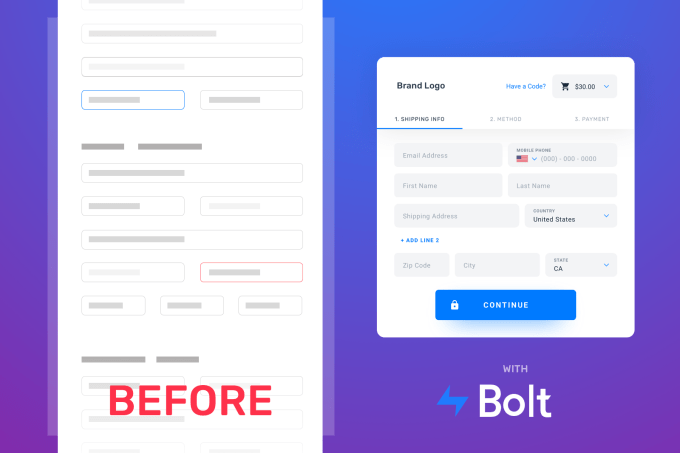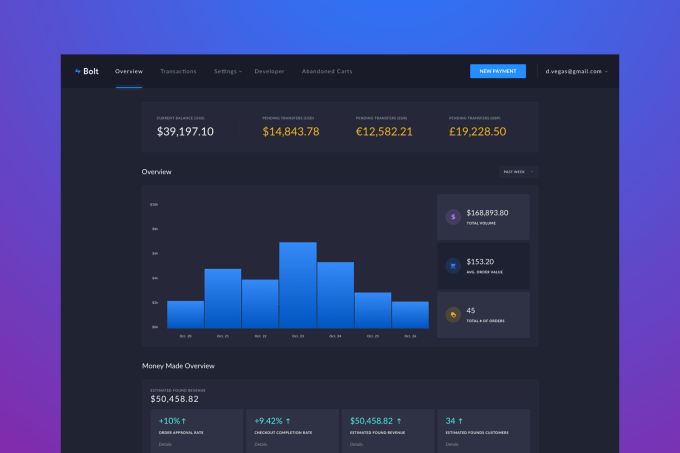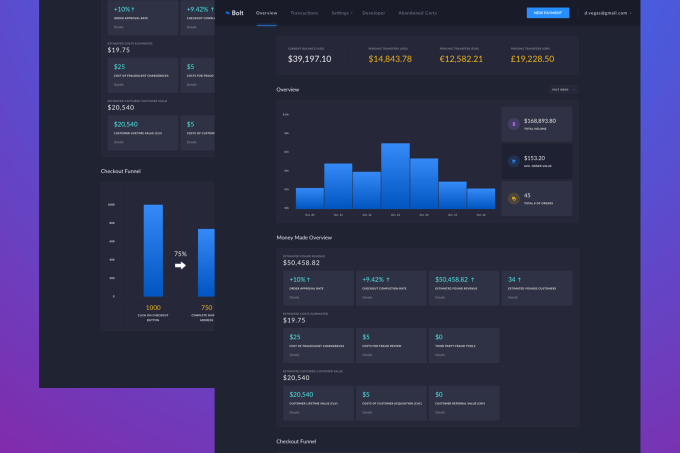A startup called Bolt wants to give e-commerce retailers a better shot at competing with Amazon. Operating in stealth for a year, the payments platform has grown to 100 online merchants who are now in various phases of roll out with its end-to-end solution for managing customer checkout, payment processing, and fraud detection.
The company was officially founded in 2014, with an initial focus on using digital currency in online checkout by Ryan Breslow, who had left Stanford to pursue the idea, and Eric Feldman. But after a year of experimenting, Breslow found there were other ways to improve the online payments experience on retailers’ sites.
“The checkout experience isn’t great – when you click ‘checkout’ and it goes through the payments step in online shopping, there are actually dozens of different underlying tools that power that,” explains Breslow.
There are tools associated with payment processing, payment gateways, and fraud detection, in addition to the checkout experience itself which has to handle calculations like coupons, loyalty, tax, and shipping fees, he says.

“E-commerce has this philosophy of layering on tools, and that layering creates fragmentation,” Breslow continues. “The insight we had at Bolt is that the more fragmented this space becomes, the worse performing online retailers become, and the more market share Amazon is going to gain.”
To address the problem, Bolt is launching a new checkout platform designed to optimize the experience by bundling all the tools retailers need under its roof.
This includes a speedier, more performant checkout page that takes advantage of a variety of techniques to boost load times – like pre-processing the front-end, so code and elements are already loaded, instead of having the site redirect you to a new page that loads from scratch.
The checkout page also reduces the number of fields customers generally have to fill in to complete the purchase – something that contributes to cart abandonment rates.
For starters, Bolt doesn’t offer the choice to “continue as guest” or login at the beginning of checkout, which Breslow says leads to a 40 percent drop-off because customers second-guess their decision.
Instead, Bolt offers post-checkout registration – customers can sign up for accounts after the site captures their payment.

Bolt also doesn’t require customers to enter their billing address, either – a fairly radical shift from how online payment processing works today.
Breslow claims that the billing address requirement – a generally accepted means of reducing fraud – is actually fairly useless at doing so.
“The more data breaches that occur, the more our personal lives become spread on the dark market, the less valuable identity information is for authenticating you,” he says. In lieu of asking customers to enter this information – another step that can cause drop off – Bolt uses technology (and the fact that it’s powering the full checkout experience) to fight fraud.
It does things like track where the mouse is moving on the page, whether someone is copying and pasting information into the fields, whether they’re making typos, how fast they’re typing, and many other factors. By analyzing customer behavioral patterns, Bolt says it has a better shot at stopping fraud than just asking for the billing address.
He claims Bolt is better, too, than the fraud detection companies currently on the market, because they’re more conservative. This leads to false positives when good orders get rejected, and reduces e-commerce retailers’ profits.
In order to assure its customers that they can trust Bolt’s fraud detection, the company covers 100 percent of fraudulent chargebacks.
While some of Bolt’s customers are still just trialing the software, even doing so is a commitment of sorts given the setup it requires – to test it, that means they have to allow Bolt to handle all their payment volume and their checkout experience.
Bolt also incentivizes retailers to switch by agreeing to match the processing fee of the merchant’s current provider.

Bolt has around 100 clients, most in the mid-tier segment – meaning revenue in the seven to eight figures. This includes Invicta (watches), Watches.com, Robert Wayne Footwear, Brian Gavin Diamonds, Adiamor Diamond Jewelry, State Bicycle Co., and others.
The startup’s technology is more expensive than competitors, Breslow admits, but claims to make up for it in sales lift. It charges a low, flat, percentage-based fee per transaction, but delivers a sales boost of anywhere from 10 to 50 percent. (The wide range is due to some clients checkout being worse than others.)
Combined, Bolt believes its speedier checkout, A/B tested checkout experience, and fraud detection will give its clients the ability to better compete in the world where Amazon’s one-click checkout dominates.
Bolt’s team of 30 full-time includes co-founder Eric Feldman; a tech team hailing from Google, Facebook, Twitter, and Airbnb; and risk team with CashStar (digital gift cards) backgrounds.
[gallery ids="1589685,1589684,1589683,1589682,1589686,,,"]
The company is backed by an undisclosed amount (“larger than seed,” says Breslow), from a number of investors including founders of PayPal, Intuit, Splunk, StubHub, and Oculus, along with Stanford’s StartX fund, their Stanford computer science professor Jay Borenstein, Streamlined Ventures, Floodgate (Mike Maples), Great Oaks VC, Trevor Traina, Brainchild Holdings, and others.
